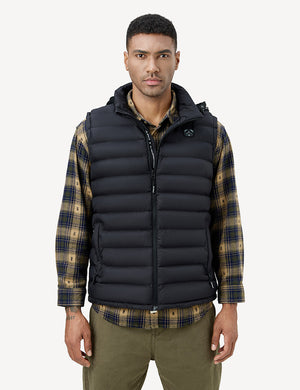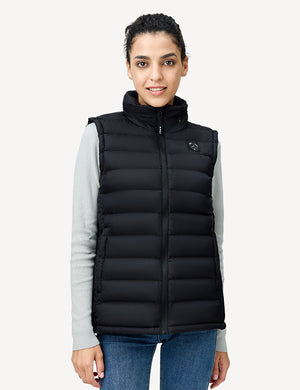A battery operated heated vest is a lifesaver for people who hate the cold and can help them battle the chill of winter. As the temperature drops and the brisk winds bite, it's more crucial than ever to stay warm. The fashionable and useful heated vest that runs on batteries can take the place of bulky, constricting winter apparel. This innovative garment has inbuilt heating elements that run on rechargeable batteries, so you can customize the amount of warmth with a button press.
Whether you're going outside, traveling, or just trying to stay warm at home during the coldest winters, the battery heated vest ensures your comfort and warmth. The perfect accessory for wintertime outdoor activities is battery operated heated vests. Going outside might be a scary idea when the snow starts to fall and the cold weather arrives.
But thanks to recent developments in heated vest technology, you can now face even the coldest days head-on. These vests have heating components that run on rechargeable batteries, giving them the ability to give rapid warmth. Whether you're skiing, hiking, or just taking a leisurely stroll in the winter, they provide a cozy, portable, and adaptable way to remain warm.
The Cold of Winter and the Necessity of Warmth
Outdoor enthusiasts face various obstacles when it comes to staying warm during wintertime activities. Environmental variables, individual comfort levels, and gear and apparel selection all contribute to these difficulties.
Cold Temperatures: The obvious problem is the rapidly dropping temperature. Cold, uncomfortable, and sometimes hazardous weather is a common feature of winter. If inadequately treated, exposure to intense cold can result in hypothermia, frostbite, and other cold-related injuries.
Wind Chill: Wind chill can considerably reduce the effective temperature, giving the impression that it is much colder than it actually is. Wind chill increases the chance of health problems associated with the cold by swiftly stealing body heat.
Moisture & Snow: Snow, sleet, and rain can cause dampness in clothing and undermine insulation. It might be difficult to stay warm when wearing wet clothing since it quickly loses body heat.
Limited Daylight: Winter brings shorter days in many places, which means there is less daylight for outdoor activities. This may make it more difficult to handle the cold and necessitate the use of extra lights or safety measures.
Variable Weather: The wintertime brings with it a lot of uncertainty and quick changes in the weather. It's important to prepare for these shifts because wearing clothing that is too light can make you more susceptible to unforeseen precipitation or sharp reductions in temperature.
Physical Exertion: Physical exertion is a common component of outdoor activities and produces body heat. It might be difficult to strike the correct balance between being warm when at rest and not becoming too hot while exercising.
Individual Tolerance: The degree to which a person can tolerate cold varies, so what one person finds comfortable may be too cold for another. It's important to recognize your own tolerance and dress appropriately.
Choices For Gear And Clothes: It's important to choose the appropriate gear and clothes. It can be challenging to stay warm due to inadequate insulation, ill-fitting clothes, or the improper kind of fabric. On the other hand, it might be detrimental to overheat and perspire while wearing too many garments.


The Importance Of Wearing Appropriate Clothing During Cold Weather Adventures
You need to dress appropriately for the weather if you want to enjoy yourself and stay safe. If not, things could not go as planned on your journey. Why it's crucial that you dress appropriately:
Protection from the Elements: The appropriate clothing acts as a shield to keep your body safe from the bitterly cold, harsh winter conditions. You are kept warm and dry by being shielded from frigid winds, rain, sleet, and snow.
Keeping Yourself Warm: One of the main concerns during cold weather is hypothermia. Wearing appropriate clothing increases your body temperature and reduces your risk of hypothermia. Warm layers and water-resistant textiles are among these products.
Reducing Frostbite: Frostbite mostly affects the fingers, toes, and nose and is caused by the freezing of the skin and underlying tissues. It is essential to wear windproof, insulated clothing to avoid this cold weather damage.
Sustaining Body Core Temperature: Wearing appropriate clothing aids in controlling your body's core temperature. The secret to layering is to keep warm air near your body and be able to remove layers when you start to feel too hot while exercising.
Maintaining Mobility: Warmth and mobility are two features of well-made winter apparel. You can move comfortably thanks to modern materials and designs, preserving your agility for your activities.
Increasing Comfort: You may not enjoy winter activities as much if you're too chilly or uncomfortable. Wearing the right clothes keeps you dry and toasty so you can concentrate on the experience rather than the discomfort.
Improving Safety: Frostbite, hypothermia, and other cold-related disorders can develop rapidly in extremely cold temperatures. You can lower your chance of experiencing these circumstances and ensure your safety when venturing outside in the winter by dressing appropriately.


How Battery-Heated Vests Work
Innovative technology is used by battery-heated vests to deliver customizable, on-demand warmth in chilly conditions. Rechargeable batteries, control systems, and heating elements are the main parts of these vests. An outline of the technologies underlying battery-heated vests is provided below:
Heating Elements
The heating elements in battery-heated vests are the essential component of their technology. Typically, conductive materials like carbon fiber, stainless steel, or wires formed of metal alloys are used to create these parts. Usually in strategic places like the chest, back, and occasionally the collar, they are woven into the vest's fabric. When an electric current flows through these elements, their high electrical resistance causes them to produce heat.
Rechargeable Batteries
Rechargeable lithium-ion batteries are used in battery-heated vests to power the heating elements. These batteries are appropriate for heating applications since they are lightweight, small, and have a high energy density. The batteries differ in capacity, with higher-capacity batteries offering longer heating periods. Usually, the vest's pockets or compartments hold these batteries.
Wiring And Circuitry
The heating elements are connected to the batteries and control systems via a network of wiring and circuitry. Because of the discreet design of this wire, wearing the vest will remain pleasant. The safety of the vest is guaranteed by safety mechanisms in the circuitry that guard against short circuits and overheating.
Control Systems
Users can customize the heat output of battery powered heated vests with control systems that let them set the desired temperature. These controls frequently come as a separate remote control or are included in the vest. To suit their own comfort level, users can choose from a variety of heat settings, usually ranging from low to high. Additionally, some vests have thermostats integrated into them that can regulate a certain temperature.
Safety Systems
Battery-heated vests frequently have safety systems to guard against overheating and guarantee user safety. These can incorporate temperature sensors that track and control the heat output or automated shutoff timers that turn the heating components off after a predetermined amount of time. This lessens the chance of extreme heat accumulation, which could harm the vest or cause the wearer's discomfort.
Including Heating Elements And Power Supply
The heating element and power supply are two of the main parts of battery operated heated vests, which are made to be warm and comfortable in cold weather. The breakdown of these parts is as follows:
Warming Component
The core component of a heated vest is the heating element. Typically, conductive materials like carbon fiber, stainless steel, or wires formed of metal alloys are used to make it. Because of their high electrical resistance, these materials produce heat when an electric current flows through them.
The heating components of the vest are positioned thoughtfully, frequently in the back, chest, and occasionally the collar. By concentrating heat on the body's core parts, these places aid in distributing heat throughout the body uniformly.
Energy Source
One or more lithium-ion batteries that may be recharged provide electricity to a heated vest. These batteries are a good fit for heating applications because of their high energy density. They give the vest a dependable supply of power and are lightweight.
Usually, the batteries are kept in special pockets or sections of the vest.
They are available in different capacities; greater capacity batteries allow for longer heating times between charges. In order to replenish the batteries, heated vests are equipped with built-in charging connectors. A USB power supply, a regular electrical outlet, or other suitable charging techniques can be connected to these ports.
How The Heating Element Distributes Heat Evenly
One of the main characteristics that make heated vests stand out as the best option for remaining warm in cold weather is their even dispersion of heat. These vests have a heating element that is positioned and developed strategically to provide even warmth throughout. These components, whether they are placed on the collar, chest, back, or any other preferred spot, blend together to produce a cozy cocoon.
When an electrical current is delivered to these heating elements, conductive materials such as carbon fiber, stainless steel, or metal alloy wires are used to efficiently generate heat. After that, the heat is distributed evenly to avoid hotspots or uncomfortable heat concentrations. Comparing this precise heat distribution to conventional layered clothes or gear can result in inconsistent warmth and discomfort
Advantages Of Battery-heated Vests
Electric heating vests are an attractive option for remaining warm in cold weather because they have several key advantages over regular thermal garments.
Adjustable Warmth: With electric heating vests, users may freely customize the degree of warmth to suit their own tastes. Conventional thermal apparel provides a set amount of insulation, which can not be enough or too much depending on the situation or activity. Users can regulate the temperature using heated vests to provide maximum comfort.
Even Heat Distribution: To disperse heat throughout the clothing in an even manner, heated vests make use of cutting-edge technologies. Traditional thermal gear, on the other hand, could have insulation flaws that cause hotspots and cold spots. This even heating distribution improves coziness and warmth all around.
Fast And On-Demand Heat: By just pressing a button, electric vests provide immediate warmth. It could take some time for traditional thermal garments to warm up, and the wearer would have to wait until their body produces enough heat to feel comfortable. This waiting time is eliminated with heated vests, which offer instant comfort.
Versatility: Heated vests can be worn as a stand-alone item of clothing or as a second layer. Conventional thermal apparel frequently comprises bulkier, less adaptable items that might not be appropriate for every activity or occasion. Electric vests may adjust to a variety of settings, including daily wear and outdoor activities.
My Personal Insight Sharing
I still clearly recall the amazing benefits of the temperature adjustment and portability of a battery heated vest from a winter camping trip deep in the Rocky Mountains. The idea was to enjoy the tranquil beauty of the snow-covered terrain for a long weekend in the backcountry. The problem was that extremely low temperatures were predicted, with nights that would be extremely cold.
This was an unforgettable event that showed me how a battery heated vest's portability and capacity to regulate temperature can completely change a wintertime journey. It's important to thrive in the cold rather than just get by. A heated vest gives you the freedom to personalize your comfort and take in the beauty of the season without having to fight the cold all year long.
How Long Does Battery Heated Vest Last?
The battery life of a battery heated vest, like the iHood battery heated vest, is contingent upon various aspects, such as the battery capacity of the vest, the temperature setting that is utilized, and the surrounding ambient parameters. These vests are usually made to be as comfortable as possible while offering a respectable working time. For example, a well-made battery-heated vest can run for 8 to 12 hours on a single charge at lower heat settings.
Maintenance And Care
Use these upkeep suggestions to make your electric vest last longer: The manufacturer's care instructions should always be read and followed in order to guarantee correct handling. To prolong their life, charge and store the batteries in accordance with the manufacturer's instructions. Steer clear of overcharging or emptying them entirely.
The majority of electric vests should be hand-cleaned with a gentle detergent. Before washing, make sure the power source is turned off and the wire is fastened. When not in use, keep your vest clean and dry to avoid mildew or damage.
Choose The Battery-heated Vest That's Right For You
Take into account the following when choosing a heated vest for a particular activity:
Activity Type: The amount of warmth needed depends on the activity. Choose a vest with temperature control for extremely strenuous activities like skiing to avoid overheating. Select a vest with strong insulation for sedentary tasks.
Battery Life: Longer battery life is essential for longer excursions, so choose a vest that has enough capacity for the whole time of your activity.
Design And Durability: Depending on your demands, choose a vest that is made for the environment in which you live. Make sure it is durable for outdoor excursions or fashionable for wearing in cities.
Conclusion
For winter outdoor enthusiasts, battery heated vests are revolutionary because they combine mobility, versatility, and on-demand warmth into a stylish package. Battery-operated heated vests are an innovative product as they provide a dependable and adaptable means of staying warm even during the coldest months. Don't let the cold stop you; discover the opportunities these vests present and make an investment in the comfort of winter to come.




